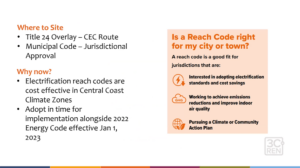July 19, 2022
Topic
Reach codes are a method for jurisdictions to pass energy policy that “reaches”, or goes beyond, California state standards for building electrification, energy and water efficiency, solar panel installation, energy audits and benchmarking. On July 14th 3C-REN hosted a Central Coast Reach Codes Policy Workshop. The goal of the workshop was to provide local jurisdiction staff and stakeholders with the latest available information to help them determine if a reach code is right for their cities, and to share lessons learned.

The event featured an overview of preliminary and draft results for Residential and Non-residential Cost-Effectiveness Studies for new building electrification, reach code support programs offered by PG&E, Southern California Edison, and 3C-REN, and a host of virtual resources offered by the Statewide Codes and Standards program. The agenda also included brief presentations from the cities of Ojai, Santa Barbara, and San Luis Obispo.
Jurisdiction representatives acknowledged the importance of limiting exemptions to avoid undermining the effectiveness of the ordinance. Kristian Hoffland of Santa Barbara and Teresa McClish of San Luis Obispo spoke to the common theme of public concerns related to grid reliability, costs, and customer choice—and how they addressed those concerns with their constituents.
The residential cost-effectiveness results delivered by Alea German of Frontier Energy revealed that All-Electric requirements for single family residential buildings are TDV cost-effective across Central Coast climate zones. TDV, or Time Dependent Valuation, is the standard for modeling cost-effectiveness of electrification measures. TDV factors the hourly variability of electricity costs. Electrification measures achieve on-bill (direct utility bill savings) cost-effectiveness with the addition of prescriptive PV and energy efficiency measures. The same is true for 3-story multi-family buildings. For 5-story multifamily dwellings, the addition of PV is required to ensure cost effectiveness. For the commercial sector, energy efficiency reach codes will be more cost-effective than all-electric in many climate zones, though heat pump HVAC systems can still provide significant cost savings.
There are a variety of resources available in the Central Coast for reach code adoption. Southern California Edison and PG&E are both sponsors of California Energy Codes and Standards Program’s localenergycodes.com website which is loaded with technical modeling, cost-effectiveness, and policy development tools. Southern California Edison and 3C-REN both offer hands-on technical and outreach support for jurisdictions seeking to adopt a reach code. Reach codes are on trend to continue as a popular tool for meeting regional emission reduction and energy efficiency goals.





